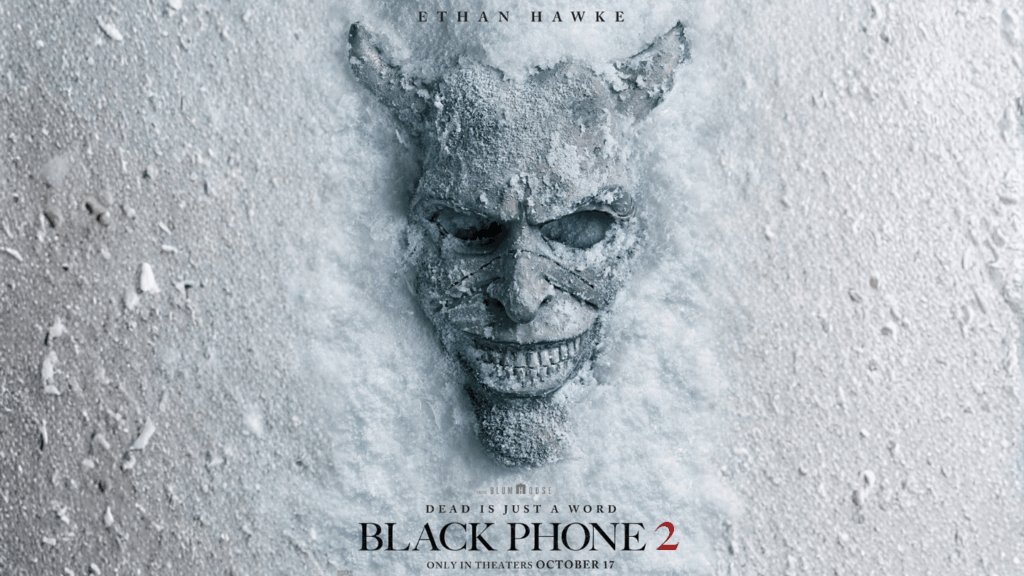By PDM | October 2025

Genre: Horror / Supernatural Thriller
Director: Scott Derrickson
Cast: Ethan Hawke, Mason Thames, Madeleine McGraw, Jeremy Davies, James Ransone
Runtime: 114 minutes
Rating: R (strong violence, disturbing themes, language)
Spoiler Warning: This review explores plot, themes, and scares in depth.
The Call Returns
The chilling phone rings again. Four years after the sleeper success of the original, Black Phone 2 reunites director Scott Derrickson with his creative team for a sequel that pushes into darker, more psychological terrain. This is not merely a reprise—it is a haunting exploration of trauma, guilt, and the echo of violence that refuses to die.
Set in 1982, the story follows Finney Blake, now a troubled teenager still haunted by his abduction and the spectral phone that once connected him to the dead. His sister Gwen, whose psychic visions helped save him, is plagued by new nightmares that blur the line between the living and the dead. When whispers spread that the nightmare isn’t over—and that the horror may have evolved—Finney must confront the ghosts of his past before they consume him completely.
Trailer Courtesy of Universal Pictures
The Premise: Fear Rewired
Where the first film trapped us in a claustrophobic basement with a single ringing phone, Black Phone 2 opens the world—literally and metaphorically. The narrative relocates to a remote, snow-covered youth camp, once the site of strange disappearances. It’s a striking change of setting: expansive, eerie, and desolate.
The filmmakers use the environment to amplify isolation. Snow becomes a visual metaphor for silence and buried secrets. Amid this stark wilderness, the black rotary phone’s ring—sometimes heard, sometimes imagined—pierces the quiet like a scream in the night. Derrickson’s direction favours atmosphere over gore; the scares creep through tension, visual storytelling, and meticulous sound design. Every ring feels like a pulse of dread.
Performances: Fear Has Faces
Mason Thames returns as Finney Blake, older but visibly scarred. Thames delivers a grounded, emotionally honest performance—part survivor, part haunted soul. He captures the weight of trying to live normally while being stalked by memories that never truly end.
Madeleine McGraw shines with quiet intensity as Gwen. The sequel gives her a broader arc: she’s no longer just the clairvoyant sister; she’s the beating heart of the film, balancing faith, fear, and fierce determination. Her visions now arrive as warnings from a place she barely understands.
Ethan Hawke returns to the role that chilled audiences—a presence that blends human cruelty with something otherworldly. Without spoilers, the mask is back, and so is the menace. His screen time is precise rather than plentiful, and his impact is all the stronger for it.
Cinematography & Atmosphere
Visually, the film is icy and immaculate. The camera embraces the cold beauty of 1980s winter Americana—dim cabins, frost-laced windows, and flickering fluorescent halls. A subtle film grain evokes vintage horror without pastiche. Lighting choices are purposeful: warm, nostalgic tones for flashbacks, spectral blues and silvers for the present, and feverish ambers for the supernatural. The aesthetic feels hand-crafted to keep you uneasy.
Editing blurs transitions between dreams, memories, and reality until certainty decays. The technique is immersive, guiding viewers into Finney’s fractured perception. You don’t watch the dread; you inhabit it.
The Music: Echoes of Fear
The score fuses analog synths with discordant strings, mirroring the phone’s static hiss. Each ring is felt as much as heard, a carefully tuned frequency that crawls under the skin. The soundtrack doesn’t merely accompany the film—it shapes it, cueing the audience to dread, release, and despair with unnerving precision.
Themes: The Ghosts We Carry
At its core, Black Phone 2 is about what happens after survival. It’s a meditation on trauma, guilt, and the cyclical nature of violence. Finney is alive, yes, but part of him remains in that basement. The ringing phone becomes a metaphor for memory and unfinished fear—an insistence that the past still has something to say.
The sibling dynamic deepens. Finney and Gwen embody two modes of recovery: the pragmatic survivor and the spiritual seeker. Gwen’s visions—once a gift—now feel like a burden she must decipher to stop further tragedy. The film hints at inherited trauma: that evil, once encountered, echoes through families and time.
Direction & Tone
Derrickson proves again he’s a stylist of dread through restraint. Where the first film tightened the screws of claustrophobia, the sequel exposes the characters to a wider, more porous darkness. The pacing is deliberate: a quiet first act of gathering shadows, a second act of psychological and supernatural incursion, and a final act that detonates the accumulated fear.
The tone is mature and reflective—less “Will they survive?” and more “What does survival cost?” It’s a bold shift that invites emotional investment alongside adrenaline.
Where It Falters
Even strong sequels stumble. A handful of dream sequences overstay their welcome, and the midsection can feel languid. The expanded mythology—particularly the explanation for what continues to stalk Finney—occasionally edges toward over-explanation. Horror often thrives on the unknown, and any attempt to define the darkness risks diminishing it.
The finale, while gripping, unmistakably sets the table for a further chapter. That forward-looking energy excites franchise fans but slightly dilutes the film’s standalone afterglow.
Character Development: Beyond Survival
Finney’s arc is compelling: a survivor grappling with PTSD, guilt, and the fear of becoming numb. His attempts at normalcy collide with a growing sense that something inside him—and around him—remains unresolved.
Gwen’s journey is spiritual and moral. Her visions force her to question faith and agency. She isn’t the child praying for a sign anymore; she’s a young woman wrestling with a destiny she refuses to accept blindly.
Even the antagonist, for all the malice, takes on the quality of a grim folk-tale—less a person than a presence. The uncertainty of what he is now keeps the mystery alive.
Symbols & Subtext
- The black phone — trauma calling back, demanding to be answered.
- Snow and silence — repression; what’s buried isn’t gone, only hidden.
- Gwen’s dreams — the test of faith when darkness speaks louder than hope.
- The fractured mask — splintered identities of villain and victim alike.
This density of meaning elevates the film above simple ghost story thrills; it’s horror that lingers.
Technical Mastery
Editing
A pulse of tension followed by eerie silence—cuts and crossfades mimic the cadence of a ringing phone. Past and present interleave until the border blurs.
Production Design
Authentic 1980s textures—rotary phones, wood-panelled walls, tube TVs, faded photographs—anchor the supernatural in the tactile.
Practical Effects
Makeup and on-set effects keep spectres tangible. Apparitions feel as though they inhabit the same air as the characters.
Sound Design
Static, whispers, floorboards—the sonic palette is the film’s secret weapon. The ring is weaponised dread.
Comparing to the Original
The first film’s power lay in simplicity: a basement, a victim, a phone to the dead. The sequel takes a risk—expanding scope, deepening lore, and trading immediate claustrophobia for lingering psychological unease. Some will miss the primal focus of the original; others will relish the evolution.
Either way, Black Phone 2 earns its place by shifting the central question from escape to aftermath.
Standout Scenes (Spoiler-Light)
- Snow-Shrouded Vision: A frozen vista where the phone rings beneath ice—simultaneously beautiful and harrowing.
- The Mask’s Return: A fractured visage that seems to reform as if memory itself is welding it back together.
- Basement Revisited: A decayed space echoing with phantom voices, weaponising nostalgia.
- The Final Call: A climactic conversation that binds two films emotionally and leaves a door ajar for more.
Horror & Intensity Guide
Graphic violence and child endangerment themes; pervasive dread; several intense jump-scares; emotionally heavy subject matter surrounding trauma and survival.
Verdict
“When the past calls, will you answer?”
Black Phone 2 is a worthy successor—terrifying, tragic, and meticulously crafted. It favours atmosphere and emotion over empty shock value, even if the mythology occasionally explains more than it needs to. The result is a sequel that dares to evolve rather than repeat.
Final Rating: 8/10
A haunting continuation that proves the scariest voices are sometimes the ones inside your head.
Keywords: Black Phone 2 review, Scott Derrickson, Ethan Hawke, Mason Thames, Madeleine McGraw, The Grabber, supernatural horror, 1980s horror, trauma in horror, Movieversalfilm review
Movieversalfilm — Your AI-powered entertainment magazine for the UK & U
